Which heater is better to choose for home and apartment: a comparative overview of units
If in the summer sweltering heat, air conditioners become bestsellers, then with the onset of cold weather, domestic heaters take over the baton of favorites according to the criteria of demand. Their use in private homes and apartments is required to improve the quality of living during the cold season.
You also thought about buying, but don’t know how to choose a heater from the impressive range offered by a number of manufacturers? We will help you to understand this issue in detail - the article discusses various types of heating devices, their pros and cons.
We also examined the subtleties of determining the required power depending on the size of the room, supplementing this article with thematic photos and video recommendations for choosing the optimal type of heater for the house.
The content of the article:
We determine the required power of the device
The power of the device is one of the key characteristics when choosing a heater. The area of the room into which heat is supposed to be supplied is another decisive factor.
If the area of the room is not heated, but has good thermal insulation, then 1.5 kW of unit power per 27 m² will be sufficient. If the room has a heating system, then a heater with a power of 1 kW is ideal for additional heating of an average room of 25 m².
What else needs to be considered for a more accurate calculation:
- temperature difference inside and outside the room;
- the level of thermal insulation of windows and their number;
- on which side is the apartment or house - sunny, shady;
- number of people living;
- age of the structure;
- the amount of equipment with heat transfer (refrigerators, televisions, computers);
- the height of the ceilings - the lower they are, the less power the heater.
Basically, for a typical apartment with ceilings of 2.5 meters and an area of 24-27 m², a device with a power of 2500 watts is suitable. For a smaller area (20-22 m²), a device of 2000 W, etc. is required.
Modern heating equipment is mainly equipped with temperature controllers, which are able to maintain the desired temperature in automatic mode.
Not always thermostats have a scale with degrees, working on the principle - more - less.
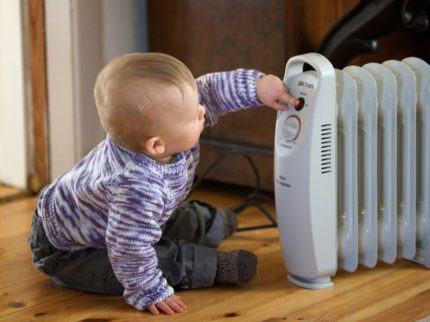
Popular types of domestic heaters
The market for heating units is vast, and it is difficult for a person who is ignorant of the intricacies of the characteristics of heat-generating devices to make a choice in favor of a particular model.
Which heater is best suited for a private house, and which will be the most functional in the apartment? To do this, it is worthwhile to study in detail all the pros and cons of heating units.
Type # 1 - Oil Devices
This type of heater is popular because of its ease of maintenance and high heat dissipation.
To get heat, you just need to move it to the zone of the desired concentration of high temperature and plug the device into a power outlet.
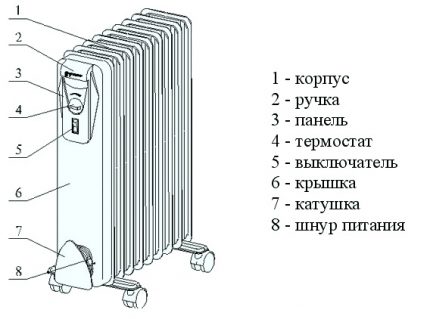
The main structural components of the oil device:
- Metal tank. It contains a coolant - a mineral oil that can “hold” and spread heat for a long time.
- A heating element. It heats the oil, which redistributes the heat to the body of the unit, and from there to the surrounding area.
- Thermostat. Located on the control panel, designed to adjust the temperature.
The device looks like a regular radiator with access to the mains. There are many models equipped with rollers, which provides mobility and versatility of use.
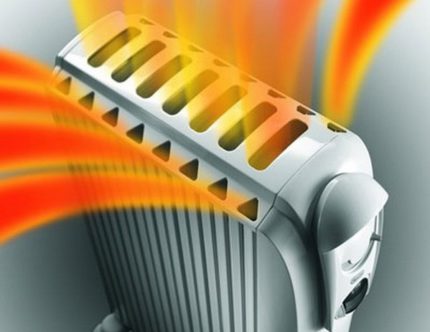
Significant advantages of a heater with an oil coolant:
- Optimum power range. The interval is from 1 to 1.5 kW, which allows you to use it to heat not only an apartment, but also a country house.
- Automatic thermostat. It makes it possible to maintain optimal temperature conditions in the room.
- Support for comfortable air humidity. The device does not dry the air, as it does not contain open heating elements.
- Price. An oil unit is inexpensive.
- Silent work. Does not cause tenants discomfort.
- Mobility. The wheels of the device facilitate its movement.
Some models have a shutdown timer to save electricity.
Negative qualities that reduce consumer interest in oil units cannot be ignored. The heating process is slow, the distribution of warm air takes a lot of time. In the event of an oil leak, burns and irritation can occur.
Are you interested in the oil type of heater? We have an article on the site with recommendations for choosing it - go linkto familiarize yourself with the material.
Type # 2 - modern convectors
The appearance of the convector heater differs from the radiator in oil with a more streamlined shape and compactness. It can easily be placed on the floor or on the wall. There are also wheeled convectors.
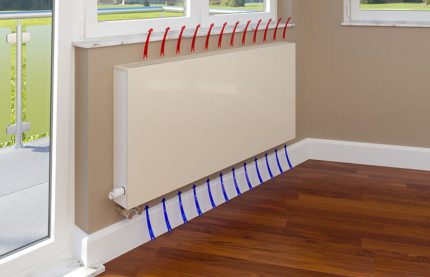
The principle of operation of the electric convector:
- The heating elements mounted in the central panel heat the air mass.
- According to the laws of physics, the heated air stream rushes to the ceiling, freeing up space for the cold.
- The air cooled under the ceiling moves back to the convector installation area, replacing the air mass heated by the unit.
The device is equipped with a sensor that takes readings about the real temperature of the air in the room. It is worth knowing that the heater is safe with respect to the possibility of electric shock, since the heating element does not come into contact with the unit body and therefore does not require grounding.

Indisputable advantages of convector type heaters:
- Noiselessness. The heating unit can work almost continuously without causing irritation.
- Safety. Structurally minimized, virtually eliminated the risk of fire and accidental burns.
- Balanced warm-up. The unit evenly delivers air flows into the treated room, which are regularly replaced by a chilled mass.
The disadvantages include a low room heating rate, which more than compensates for the ability to keep the temperature background due to the presence of a thermostat. Devices do not need thorough control, as the same device turns off and turns on the heater when the set temperatures are reached.
Convector heating devices are produced in two variations of the installation: wall and floor. There are more admirers of the wall variety as the most convenient, not obstructing movement.

A rational place for the location of a convection device is considered the area under the window opening. In this position, he will not only process the air in the room, but also form a kind of air curtain that will prevent the penetration of cold streams from the street.
Not sure which convector is best for your room? We recommend that you read the recommendations for convector heater selection for home.
Type # 3 - fan heater
The fan heater is, in fact, an advanced convector. Its system uses thinner heating elements, and the movement of the air flow stimulates its own fan. The unit attracts with small dimensions and similar weight; special skills are not needed in its installation and operation.
Fan heaters are equipped with different types of heating elements, including:
- Nichrome wire spiral. It is wound on a rod of non-combustible material, most often ceramic or graphite. May be open or enclosed in a glass flask. An inexpensive option, but often spreading the smell of burnt dust that settled on it during operation.
- Ceramic plate.It differs in a larger area than a spiral, therefore it heats up faster. The plate has holes through which the heated air stream runs. It costs almost three times more than the previously described option.
- Metallic or graphite heater.This type of heater is placed in a tube, the remaining space in which is filled with sand or manganese oxide. This scheme allows you to evenly distribute heat. It has more power than previous types, and upsets with an impressive price.
In addition to the listed heating elements, there are all kinds of variations on the theme of heating appliances and devices. The principle of operation of all types of units is simple: the device draws in air from the room, passes it through the thermal element and feeds it back.
You can even assemble a fan heater yourself, using improvised materials. And how to do this we examined in detail in our other article.
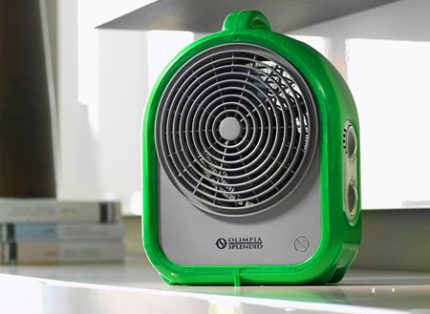
The list of advantages of fan heaters:
- Speed. The fastest heating of the air, thanks to the intensive circulation of the flow.
- Universality. It can be used as a heater in the winter, and as a fan in the summer.
- System protection. The thermostat does not allow the device to overheat.
- Wide choose. A wide selection of models - mobile, stationary, etc.
- High efficiency (85%). High productivity reduces energy consumption.
Among the disadvantages are the fact of unwanted air drying. Units during operation are noisy, sometimes they burn dust and spread a negative smell. The latest models are protected from dust settling on the working tool and from moisture entering the system.
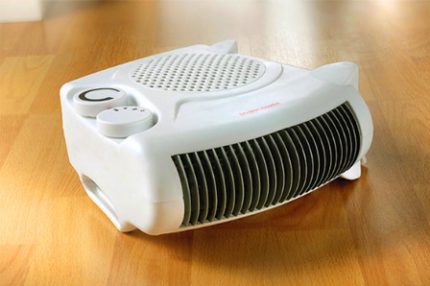
The fan heater can serve as an additional source of heat, in the presence of basic heating, since its radius of action is limited. The main thing is to choose the right device. In order not to be mistaken in this matter, we recommend that you familiarize yourself with the material on fan heater selection.
Type # 4 - thermal curtains
Such devices are most often used to supplement engineering communications systems at commercial and industrial facilities - factory workshops, supermarkets, and shopping centers.
But in private homes, thermal curtains are also sometimes installed to create a barrier to cold air and to keep heat indoors. Devices create a stream of warm air from top to bottom. Such a unit is able to heat a small room (25 m²).
Systems work according to the principle common to all heaters. In the case of devices there is a heating element and a fan of high power. A powerful fan directs the air flow in a specific direction, the heating element heats it.
In addition to standard heating operation, the units create an air obstacle for drafts.
Thermal veils are mainly used as additional heat-generating elements. They will be appropriate above the front door of a country house.
Advantages of devices:
- Profitability. They contribute to heat conservation, as creating a barrier to the penetration of air from the outside, at the same time prevent leakage to the outside.
- Excellent protection. Keeps away street dust, harmful exhausts and insects. Isolates space from cold air currents.
Among the minuses are high cost and increased energy consumption. Able to heat only a small room and is used mainly in combination with other heating equipment.
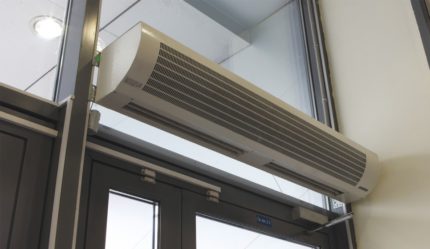
Type # 5 - Classic Electric Fireplaces
This device is very often used as an element of the interior, focusing more on its aesthetics than on functional qualities. However, electric fireplaces are able to qualitatively heat the room. There are many types of this climatic equipment: island, corner, built-in, suspended, mobile.
Structural elements of electric fireplaces:
- Heating system. Heating spirals or heating elements are located on the top of the panel.
- Air supply device. The built-in ventilation system supplies air to the heating elements, and then to the room, while cooling the case and preventing overheating.
The thermostat controls the operation of the fireplace in automatic mode, responding to changes in the temperature background. Devices can also perform a decorative function - to simulate the illumination of fire.
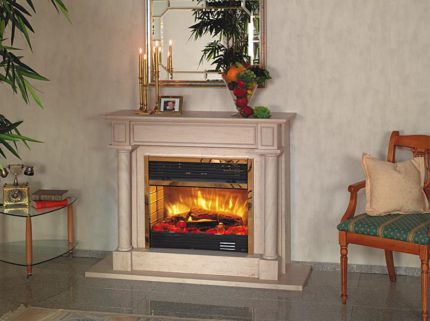
Positive aspects of the electric fireplace:
- Simplicity. It does not require special installation, unlike a wood fireplace. It does not require laborious maintenance and cleaning of carbon deposits.
- Aesthetics. Creates a special atmosphere in the room. Thanks to the many models it fits easily into the urban and suburban interior.
Electric fireplaces do not require a separate room, do not emit combustion products, for the removal of which it is necessary to arrange a chimney.
An electric fireplace is able to heat the room as the main source of heat in accordance with power indicators.
The downside is the high power consumption of 2-2.5 watts per hour in active mode. Mandatory wiring of a modern sample is necessary - old wiring may not withstand voltage and cause a fire. The fireplace dries the air and burns out oxygen.
If you still want to get a fireplace, and the electric version is not suitable for you, we recommend that you pay attention to biofuel fireplaces.
Type # 6 - infrared heater
Infrared options are considered a new generation of technology and differ from fireplaces and oil radiators in a different operating principle. Their action is aimed at objects available in the room.
IR heating devices do not heat the air mass, but objects that transmit it into the surrounding space.
Devices are available in the form of traditional heaters, ceiling panels, film systems for devices under floor coverings or wall decoration. A detailed analysis of models and tips for choosing IR heaters given here.
They can be used as the main source of heat and as an auxiliary. Artificial infrared radiation is the closest in spectrum to natural light.
However, it should not be taken as a natural source of heat. By itself, it is not harmful, but, being under a ceiling heater for a long time, for example, you can get a heat stroke identical to the sun.

Advantages of infrared heaters:
- Long term work. In infrared heaters, not parts that can periodically burn out, gradually wear out. Mechanically damaged elements are easily replaced.
- Economical installation. Or styling regarding film systems. All work on the device and installation are carried out without problems at an operational pace.
- High-speed heating. Infrared heaters do not differ inertia, quickly warm up zones and rooms.
- The probability of zone heating. The operation of devices can be focused on a specific zone or group of objects.
- Ability to work in open areas. They can be used to heat open spaces: terraces, sports grounds, etc.
- Noiselessness. Instruments and film heating systems operate without making sounds.
- Preservation of air humidity. IR equipment does not heat; as a result, it does not dry air. His work does not worsen the indoor climate.
The list of cons is volatility. This means that if used as the main source of heat, it is necessary to consider a backup power supply device.
Not everyone is satisfied with the backlight of the control panel, which operates continuously during the operation of heaters. To protect against power surges and current leaks, you will have to purchase expensive automation.

Such a device is suitable for heating houses from a log house, as it warms up wooden walls well and does not require project documentation for installation. In addition, energy savings are significant, compared with other electric heaters - 6-7 times.
One of the varieties of infrared heating devices is a carbon heater equipped with an element also known as. We recommend that you look at our other article with a detailed overview of the species. infrared carbon heater and selection recommendations.
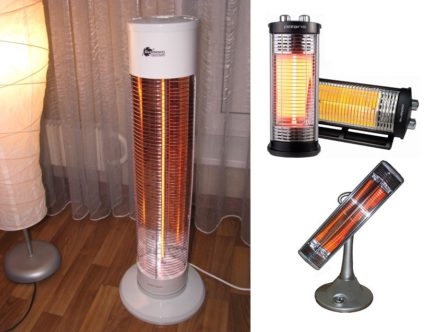
Type # 7 - Monolithic Quartz Heaters
The quartz monolithic group by the principle of action refers to convector-type heaters. The device is simple: it is a panel made of a molten mixture of quartz sand with a small amount of marble chips.
Inside the panel there is a spiral heating element that can heat up to 120 ° C. The spiral transfers thermal energy to an inert quartz case, as a result, the device heats up only to 95 ° C.
The quartz case works on the principle of wood - it retains accumulated heat for a long time. The use of this category of devices will help to save, because units do not need to be constantly running.
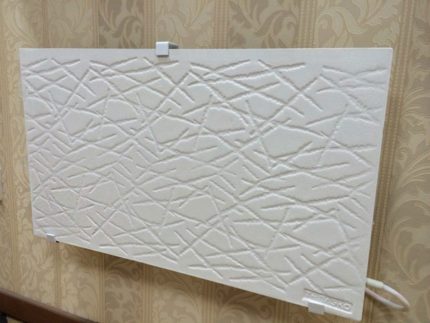
Advantages of monolithic quartz case heaters:
- Economical energy consumption.Cost reduction is achieved due to the body's ability to accumulate and slowly give off heat.
- Easy installation.The installation will be mastered by an inexperienced performer, acting in accordance with the instructions supplied by the manufacturer.
- Does not dry air. The heater enclosed in a monolithic housing does not affect the microclimate. For the same reason, it does not burn dust and does not spread unpleasant odors.
- Suitable for wet rooms. A sealed housing protects the spiral from contact with splashes and a damp environment.
- Safety. The shell never warms up to critical temperatures that contribute to fire and cause burns.
Monolithic modifications are equipped with thermostats that control the operation of devices. When leaving, for example, from the cottage at the end of the season, the units can be set to a minimum temperature of + 95 ° C.
The cost of devices is low, but their weight is quite impressive. Also, not everyone likes the appearance of the heater, but the ability to put special removable panels of any color eliminates this problem. This type of heater is the best option for heating an apartment or a private house.
We suggest you to look at a detailed guide to choice of quartz heater for home and for giving.
Type # 8 - halogen appliances
The difference between halogen and infrared heaters in a special heating element. It consists of a tube filled with an inert gas with a tungsten filament inside. Gas prevents the destruction of the tungsten filament, chemical reactions within the tube are excluded.
Otherwise, the principle of operation of halogen devices is similar to the action of infrared heaters.
Pros of halogen lamps:
- Saving. Reduced energy consumption compared to electric fireplaces or oil radiators.
- Mobility. Floor heaters can be installed in different places requiring increased heating.
- Fast heating. Provided with design features of the working element of the unit.
Most models have rotary mechanisms that allow you to direct the heat flow in the required direction.

Disadvantages include too bright light supplied by the device. It is harsh and unpleasant, especially at night. the second minus is an excessively fragile tube, which will periodically have to be changed.
Many also noted that with halogen lamps it is difficult to heat the entire room and reach the desired temperature in it. The heater warms only within the limits of direct action.
Type # 9 - Micathermic Heaters
Despite the relatively small size, the mycothermal type of devices pleases with high efficiency. This novelty in the market of heat generating units has already declared itself adequately, but consumers are still wary of it.
They do not dry out the air in the process of quite quick and efficient heating.
The heating element, created using Micatherm technology, is a kind of sandwich assembled from two layers of mica with a nickel mesh between them.
Heating is done by a grid, and mica is responsible for the temperature balance and mechanical strength. The devices combine the principles of heating convectors and infrared systems.
Convincing advantages of mycothermal heating devices:
- Reduced energy costs.Electricity consumption is 25% less compared to conventional heaters.
- Preservation of humidity.An additional plus - the units do not burn out oxygen like many types of electrical appliances.
- Safety. The risk of burns and fires is structurally excluded.
It is not recommended to dry laundry on the mycothermal heater, if necessary, cover it with a cloth. This can cause damage to the unit.
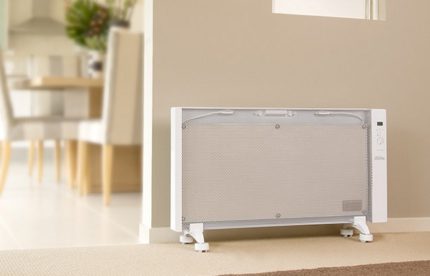
However, the device does not fit the role of the only source of heat in a living room, but it will be a good addition to emergency heating of a certain area.
You have not yet decided whether this type of heater is right for you? We recommend that you familiarize yourself with a detailed analysis of the pros and cons, as well as features selection of mycothermal heater.
Type # 10 - Heat Guns
When wondering how to choose the best heater for an apartment or a private house, many pay attention to heat guns. Such a unit can perfectly cope with the role of the only heat source in a country house.
Arranged devices without any special expenses. The fan inside the housing supplies air to the heating element, distributing flows into the room. The thermostat regulates the operation of the device, excluding its overheating.
What are the advantages of using a heat gun:
- Mobility. The device can easily be moved from place to place.
- Speed and efficiency. The unit is able to quickly heat a large area. It is used for heating large areas, in construction it is used as equipment providing conditions for drying monolithic structures and for work.
- Performance. It can be the only source of heat in the absence of an alternative.
Before using the heat gun, you need to make sure that the wiring can withstand such a load. Houses with old wiring are not suitable for heating with such an element due to the high probability of fire.
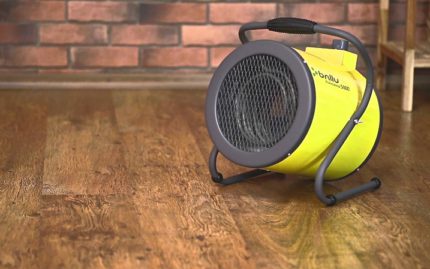
True, the heat gun consumes a lot of energy. Most models connect to a three-phase production network. When using such powerful equipment, the installation of protective automation will be required.
Modernization of heating appliances offers consumers new products that are used for their intended purpose, and also serve as an unusual decor in the interior.
Have you decided to stop buying this type of heater? We recommend that you familiarize yourself with the criteria heat gun selection.
Heater Type Recommendations
So, for stationary heating of the room, you can safely choose an electric fireplace or heat gun as the main source of heat in a private building.
First, it is necessary to carry out all calculations of power and area of the room. As a source of additional heat or a means for emergency spot heating of certain areas, all other models are suitable.
To equip the entrance to the suburban mansion, a thermal curtain is suitable if its residents are actively moving from the street to the house or vice versa.
We recommend buying convenient oil mobile radiators, convectors or safe infrared and macothermal systems as sources of additional heat in the event of a centralized network accident or insufficiently high temperature in housing.
In case of prompt injection of warm air in different rooms, we advise you to purchase a portable fan heater.
Conclusions and useful video on the topic
Comparative overview of heating options:
Details on the selection rules and features of convectors:
The specifics of the operation of infrared heaters
Knowing how to choose a heater for an apartment or a house, you can save yourself from the inconvenience associated with the unsuccessful selection of heat-generating devices - high electricity consumption, excessive noise or light, the inability to heat the room completely.
You still can not decide on the suitable type of heater for your house or apartment? Perhaps you still have questions after reading our article? Ask them in the comment block - we will deal together.
Or are you already a happy owner of the heater? Tell us what type of heater you preferred and are you satisfied with its operation? Did our reviews and tips help you? Leave your comments and add a photo of your heater under this article.

 How to choose a convector heater: a comparative review and recommendations before buying
How to choose a convector heater: a comparative review and recommendations before buying 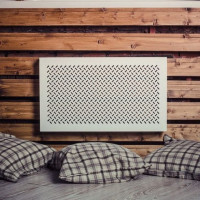 How to choose a quartz heater for home and garden: the pros and cons of models, a review of manufacturers
How to choose a quartz heater for home and garden: the pros and cons of models, a review of manufacturers 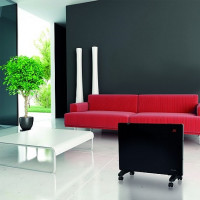 What is better to buy - a convector or fan heater? Comparative review
What is better to buy - a convector or fan heater? Comparative review 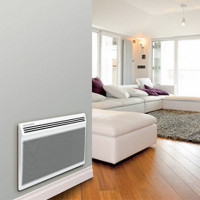 How to choose a micathermic heater: overview of types and selection tips
How to choose a micathermic heater: overview of types and selection tips  How to choose an infrared carbon heater: an overview of the types and tips for customers
How to choose an infrared carbon heater: an overview of the types and tips for customers 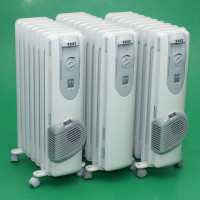 How to choose an oil heater: tips for customers and an overview of the best options
How to choose an oil heater: tips for customers and an overview of the best options  How much does it cost to connect gas to a private house: the price of organizing gas supply
How much does it cost to connect gas to a private house: the price of organizing gas supply  The best washing machines with dryer: model rating and customer tips
The best washing machines with dryer: model rating and customer tips  What is the color temperature of light and the nuances of choosing the temperature of the lamps to suit your needs
What is the color temperature of light and the nuances of choosing the temperature of the lamps to suit your needs  Replacement of a geyser in an apartment: replacement paperwork + basic norms and requirements
Replacement of a geyser in an apartment: replacement paperwork + basic norms and requirements
As usual in the fall, when it is already cool in the yard, and the heating in the apartment has not yet been switched on, you are thinking about purchasing some kind of heater. After reading the review, the most reliable seemed the traditional oil device. Only one question remained incomprehensible: what kind of power is needed for a room of 25 sq.m. (at the beginning it is indicated 1 kW, and then 2.5 kW)?
Good day, Andrey. Oil fireplaces with a thermostat and a fan on the body are really very practical. For heating apartments, the required heater power is determined at the rate of 1 kW per 10 m2. For additional heating of the room / apartment at the rate of 1 kW per 20 m2.
I advise you to pay attention to infrared heaters, more suitable for heating large areas.
Hello. This is the formula for ceilings at 2.75. In general, correct if I am mistaken, the calculation is 25 squares:
Dhsh = P (room area)
P / Vp (ceiling height) = O (volume)
O / 25 = power
A) Having multiplied the length of the room by the width, we get the area. B) We divide the area on the height of the ceiling and obtain a volume. B) We divide the volume by 25 (from the calculation of 2.5 kW to 25 square meters), and obtain the power.
There used to be an oil heater at home, but it really loaded the network, sometimes it caused traffic jams. Plus, they are also dangerous because of the possibility of spillage in case of damage to hot oil. Therefore, they abandoned it in favor of an electric convector. It is safer and more modern. My mother-in-law has a fan heater - so I won’t advise anyone. She turned it on at night, nobody could sleep: it was buzzing like a vacuum cleaner and the air was very dry.
The fan heater is cheap and cheerful. All life in the hostel with them has passed) Now at work they gave a new office. I’m sitting alone, my legs freeze. I remembered about the duychik, quickly ordered it for auto, now it's warmer, of course. True, he devours air and after a couple of hours of work it is necessary to ventilate the room, otherwise the yawning begins incredible.
Still, compare the options at prices to find out what is possible to buy for a specific salary.
Yeah, duys are a thing) I also just wanted to buy one in every room, but my husband insisted on buying a more serious heater. We reviewed a bunch of options, I didn’t even know how difficult it is to choose them and how many of them in general! In general, it was a long song, but we found our option - floor quartz. On Avito, it cost 4,000 rubles, so they ordered it there. Delivery was at the boxberry point, which is better, there is inspection before payment. The heater is excellent and suitable for any room. We put it in the bedroom. It is compact in size, can even rotate and warms up the whole room in a short period of time. No strong temperature changes are felt, it is comfortable with it. Cons have not yet been discovered.
Thank you for the helpful information!